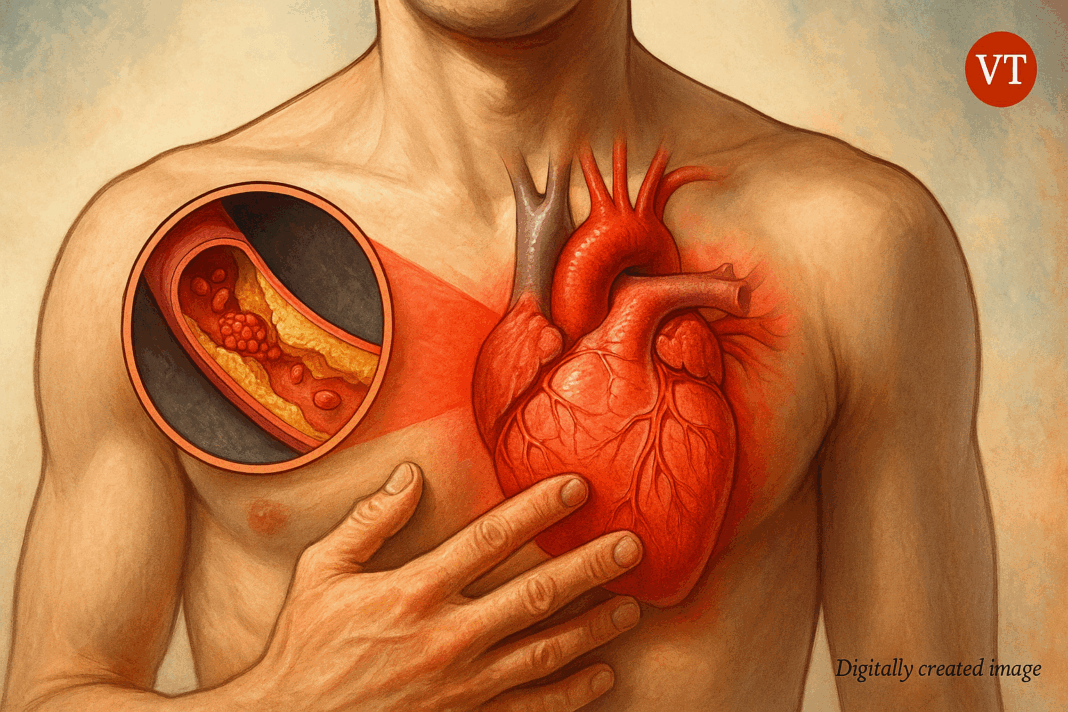Highlights:
- Heart disease is caused by plaque buildup in the arteries, which can lead to heart attacks and heart failure.
- Cholesterol plays a major role: LDL is harmful, while HDL is protective.
- High blood pressure adds extra strain on the heart and increases risk.
- Healthy lifestyle choices can prevent or reverse early heart disease.
- Medical treatments include medication, lifestyle changes, and surgery if needed.
Heart disease is often called the “silent killer,” and for good reason. It develops quietly over time and often doesn’t show serious symptoms until something dramatic—like a heart attack—occurs. But understanding what’s really happening inside your body can help you prevent it, manage it, and live longer.
🫀 What Is Heart Disease?
Your heart is a strong muscle that pumps blood to every part of your body. Think of it like a water pump and your blood vessels like a system of pipes. Over time, fat and cholesterol can build up inside the walls of these pipes. This buildup is called plaque.
Source: American Heart Association (AHA)
As the plaque grows, the space inside the blood vessels gets smaller, and blood has a harder time getting through. This condition is known as coronary artery disease, the most common type of heart disease.
If one of these vessels gets completely blocked, the blood supply to part of your heart muscle is suddenly cut off. That’s when a heart attack happens. The heart muscle begins to die because it can’t get oxygen.
💥 What Causes Plaque? The Role of Cholesterol
Cholesterol is a waxy, fat-like substance found in your blood. Your body needs some of it to build cells and produce hormones. But too much of the wrong kind can cause serious trouble.
There are two main types:
- LDL (Low-Density Lipoprotein) – Often called “bad cholesterol.” When there’s too much LDL in your blood, it sticks to the walls of your arteries and forms plaque.
- HDL (High-Density Lipoprotein) – Known as “good cholesterol.” HDL helps carry LDL away from your arteries and back to the liver for removal.
LDL builds the clogs. HDL helps clean them out.
Source: American Heart Association (AHA)
⚠️ Why Heart Attacks Happen
What usually triggers a heart attack is a blood clot. Imagine your artery already has a lot of plaque. One day, that plaque cracks or ruptures. Your body sees the crack as an injury and sends blood cells to form a clot.
But this clot can completely block the already-narrow artery, stopping blood from reaching your heart. Without quick treatment, that part of your heart can’t recover.
Source: Cleveland Clinic
💢 The Role of Blood Pressure
Blood pressure is the force of blood pushing against the walls of your blood vessels. If your arteries are narrowed by plaque, your heart has to work harder to push blood through. That raises your pressure.
High blood pressure is like forcing water through a pinched hose. It damages the arteries faster and increases your risk of heart attack, stroke, and kidney failure.
Source: Centers for Disease Control and Prevention (CDC)
🩺 What Are the Signs?
Not all heart disease shows symptoms, but common warning signs include:
- Chest pain or tightness
- Shortness of breath
- Pain in the neck, jaw, shoulder, or arms
- Fatigue with mild activity
- Dizziness or fainting
Women may feel less obvious symptoms—like nausea, back pain, or even anxiety—during a heart attack.
Source: National Institutes of Health (NIH)
🥗 How to Protect Your Heart
Here are everyday steps that make a big difference:
✅ Eat Heart-Healthy Foods:
- Whole grains, vegetables, fruits, lean protein, and healthy fats
- Limit processed foods, red meat, sugar, and sodium
- Eat foods that raise HDL and lower LDL—like oats, beans, salmon, and avocado
Source: Harvard T.H. Chan School of Public Health
🏃 Stay Active:
Get at least 30 minutes of exercise most days—walking, biking, swimming, or dancing all help.
🚭 Quit Smoking:
Smoking harms blood vessels, lowers oxygen in the blood, and increases clotting risk.
🧘 Manage Stress:
Practice deep breathing, meditation, or any calming activity to reduce pressure and inflammation.
⚖️ Maintain a Healthy Weight:
Especially around your waist, excess fat increases your risk of heart disease and high blood pressure.
💊 What If You Already Have Heart Disease?
If you’ve been diagnosed with heart disease, you’re not powerless. Many treatments can help you live a full life.
- Medications – to manage cholesterol, blood pressure, or prevent clots
- Lifestyle changes – continue to be crucial
- Medical procedures – like angioplasty or bypass surgery when needed
Keep regular appointments with your cardiologist and stick to your treatment plan.
❤️ Final Thought
Heart disease may be common, but it’s not a mystery—and it’s not your destiny. It all comes down to how well you understand and care for the system that keeps you alive.
If your heart is the pump and your arteries are the pipes, cholesterol clogs them, and high blood pressure adds pressure to the system. The solution? Clear out the pipes, ease the pressure, and fuel your pump with good habits.
The good news: it’s never too early—or too late—to start.
If you regularly experience chest discomfort, shortness of breath, or unusual fatigue, it might be worth exploring whether you have early signs of heart disease. Keeping a lifestyle journal or speaking to a healthcare provider can help.
*This article is for educational purposes only and does not constitute medical advice. Please consult a qualified healthcare provider for personalized care.*
A global media for the latest news, entertainment, music fashion, and more.















